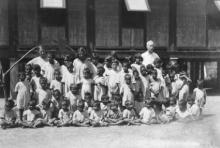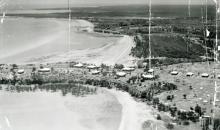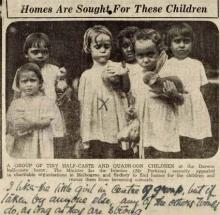Darwin (Larrakeyah)
The Kahlin Compound was opened to segregate and control the Aboriginal and Torres Strait Islander peoples who were forcibly moved there. Men, women and children lived in an area fenced off with barbed wire, and discipline was strictly enforced. In 1924 most of the children at Kahlin were taken away to the 'Half Caste Home' at Myilly Point. This home was opened because an inquiry recommended that children who were labelled 'half caste' under legislation and government policy should be removed from their families and communities. The inquiry also recommended that these children be isolated from other Aboriginal and Torres Strait Islander peoples, and placed in a segregated institution where they 'could be disciplined and trained to their place' in the community .
0Established in 1913 by the Northern Territory State Government, closed in 1939.
Kahlin CompoundKaren George and Gary George, Kahlin Compound (1913 - 1939) (15 December 2014) Find & Connect https://www.findandconnect.gov.au/ref/nt/biogs/YE00032b.htm
NTWhen anybody come to pick up a worker they used to line us up and they'd make you flex your muscles. If you were big and strong they'd pick you - like a slave market. I was sent out at 11. I worked there for seven and a half years, never got paid anything, all that time. We used to bring the cattle in ... we didn't get nothing. So I had to join the army to survive (p. 99).
There's where food was scarce again. Hardly anything ... night time we used to cry with hunger, y'know, lice, no food. And we used to go out there to the town dump ... we had to come and scrounge at the dump, y'know, eating old bread and smashing tomato sauce bottles and licking them. Half of the time our food we got from the rubbish dump. Always hungry there. That's another thing - culture was really lost there, too. Because religion was drummed into us, y'know, when we'd be out there and we'd have knuckle-up and that, we were that religious we'd kneel down in prayer ... We had to pray every time you swear or anything, you'd go down on your hands and knees ... they pumped that religion into us (p. 117).
There was no food, nothing. We was all huddled up in a room ... like a little puppy-dog ... on the floor ... Sometimes at night time we'd cry with hunger, no food ... (p. 138).
I was sent out when I was eleven years old to [pastoral station]. I worked there for seven and a half years. Never got paid anything all that time. [Even] Aboriginal people I was working with used to get 30 bob. Yet we didn't get nothing. I used to say, 'Where's my money?' 'Oh, they put it into the trust account.' So I worked there for them. Oh rough, hardly any food or anything, put out in remote area on me own, drawing water and that, looking after cattle ... no holiday, no pay. I never received one pay that seven and a half years I was there (p. 150).
Confidential evidence 549, Northern Territory: man removed to Kahlin Compound at 3 years in the 1920s or 1930s; subsequently placed at Pine Creek and The Bungalow.
Human Rights and Equal Opportunity Commission, Bringing them Home: National Inquiry into the Separation of Aboriginal and Torres Strait islander Children from Their Families (1997)
3 years Confidential evidence 549
Kahlin Compound, 1928

Kahlin Compound, 1937-46

Kahlin Compound, 1934-35: The handwriting reads "I like the little girl in the centre of group, but if taken by anyone else, any of others too will do, as long as they are strong".
